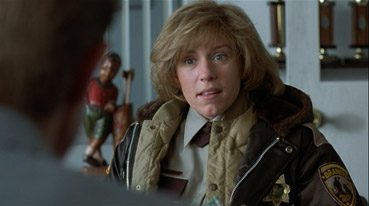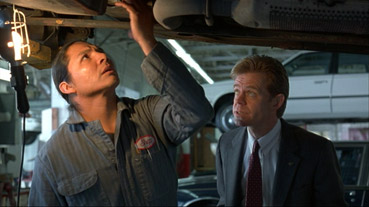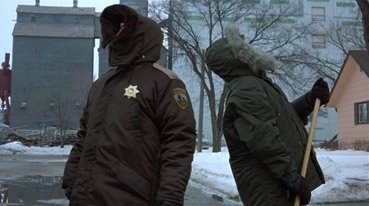|
For
my money, from the moment Joel and Ethan Coen started
making movies, they have been two of the most consistently impressive and
imaginative filmmakers working in American cinema. Since
their wonderfully dark neo-noir debut Blood Simple,
they have tackled a string of genres and every time have
come up with something completely new. Raising Arizona
was an extraordinary kinetic comedy of family, devotion and disaster, Miller's
Crossing put a new slant on the gangster movie, The
Hudsucker Proxy was a semi-surrealistic take on the cinema of Frank Capra,
and Barton Fink was a nightmare spin on the rookie-comes-to-Hollywood
tale. For some, the road to Fargo has been an uneven
one, but I would champion every one of the aforementioned
titles as cinema of the highest order. Barton Fink I regard
as a dyed-in-the-wool masterpiece, but like all their preceding
films it reached an unfairly narrow audience. It was considered
just too odd, too 'out there' for many, but I know I was not the only one who sat slack-jawed with
amazement as the film unfolded. I guess it was in part because of this history
that I was both surprised and unsurprised by the widespread
critical acclaim that greeted Fargo – unsurprised
because this is what the coens have been doing all along – making
astonishingly individual and imaginative films from super-smart scripts around compellingly offbeat characters – but surprised because
it seemed to have taken some observers so long to appreciate this. Unlike its predecessors, Fargo seemed
to work for just about everybody, and the joy of the film is that this was
not the result of any sort of compromise on the part of
the filmmakers – Fargo is quintessential Coen
Brothers: quirky, inventive, wonderfully performed,
and genuinely unlike anything else around.
The
set-up is seemingly straightforward but still pleasingly offbeat. Car salesman
Jerry Lundegaard (William H. Macy) has money problems, something he intends to put right by hiring two would-be kidnappers, Carl Showalter (Steve Buscemi) and Gaear Grimsrud (Peter Stormare), to abduct
his wife Jean (Fargo native Kristin Rudrüd) and demand a ransom from her wealthy father Wade (Harve Presnell), the intention being to split
the ransom money evenly with his criminal cohorts. Almost nothing
goes to plan. The kidnappers have issues from the start
both with Jerry and each other, and after a clumsy abduction,
events take a very serious turn for the worse when a patrolman
and two motorists are brutally slain
(in a scene that directly references a key sequence in Blood
Simple). Enter Marge Gunderson (Frances McDormand), Fargo's heavily
pregnant female chief of police, who is charged with the
job of putting the pieces together to solve this multiple
homicide.

On the surface at least, Fargo
is a crime drama, but unlike any you've
likely ever laid eyes on. Set in an area of Minnesota where the majority of residents are of Scandinavian descent, the accents
make even the delivery of straightforward lines unique,
and the relentless cheerful attitude of the locals gives
most exchanges a oddly engaging air of optimism. As always with the Coens, character is key, and here it brings a joy
to almost every action and line of dialogue, which has the effect of casting even familiar situations in a new
light. We've watched police looking over the bodies of murder
victims countless times before, but I can pretty much guarantee you've never
seen the chief of police stop with seeming surprise in
the middle of the examination, bend over as if she's discovered
a vital new clue, then reveal that it's a reaction to morning sickness.
This
is a film about greed, loneliness, stupidity and self-interest.
Jerry is married with a young son and not only feels
unable to share his rapidly deteriorating financial problems
with his wife, but is willing to put her through the trauma
of a kidnapping to correct the situation.
Would-be kidnappers Carl and Gaear, meanwhile, are so pettily
self-motivated that they eventually come to blows, not over
the substantial ransom but who will take the
car that was thrown in with the deal. Marge's former
school friend Mike Yanagita's (Steve Park) desperation for companionship
prompts him to make a complete spectacle of himself in front
of her, and even Marge's husband Norm (John Carroll Lynch) is so caught up in
a painting competition that he never once
asks Marge – a pregnant woman investigating a multiple shooting
– how her day has gone. But in other ways Marge and Norm
are the stability at the centre of spiraling chaos – their love for each other is genuine and the two appear most content with their lives
as they are, the flipside of Jerry's marital discontent. And it's perhaps typical of a film that bristles with the unusual that we
are a good third of the way into the story before Marge makes her first appearance.
Part
of Fargo's delight comes from it's near perfect melding
of character and narrative – neither is made to suffer at the
expense of the other, and in the tradition of great storytelling
the narrative is propelled forward at every turn by those around which it is constructed.
At the core is a superb screenplay that lays out the story
and dialogue in more precise detail than you might imagine, right down to Jerry's seemingly
improvised umms and ahhs when discussing the plan with the would-be kidnappers. There is a stylised yet somehow 'real' quality
to the dialogue and its delivery, most apparent in the work
of the smaller roles: the two girls (Larissa Kokernot and Melissa Peterman) interviewed about having
sex with the kidnappers; the irate customer (Gary Houston) who struggles
with his own natural politeness to angrily call Jerry "a
f...f...fucking liar!"; the old man (Bain Boehlke) who pauses clearing the snow from his drive to deliver a hilariously deadpan witness
statement to patrolman Officer Olsen (Cliff Rakerd)... there isn't a single
character, no matter how brief their appearance, who doesn't make their mark in some way.

So much of this is down to some savvy casting and a string of uniformly excellent performances. Francis McDormand won an
Oscar for her portrayal of Marge and just this once it was richly deserved. This is a terrific part, wonderfully
written, but McDormand brings so much to it, making every
line and gesture register, from the everyday – her joyful
"Hiya hon!" on finding Norm waiting for her at
the police station – to the memorably offbeat, as when she smilingly asks the girl who hadsex with Carl Showalter, "Was
he funny looking apart from that?" after she reveals that he wasn't
circumcised. William H. Macy is at the top of his considerable
form as the hapless Jerry Lundegaard, wonderfully communicating
his doom-laden, nervous
uncertainty about just about everything through facial expression and body language. He repeatedly shines in the smallest of moments, a favourite being his frustrated
attempts to clean ice of his windscreen that degenerates
into a furious flailing of arms, only for him to eventually
return, resigned, to his original task. Steve Buscemi finally
moves up from Coen bit part player to major role as the
wonderfully sleazy would-be kidnapper Carl, unlikable to the point of infuriating at times and yet somehow still a compelling
screen character. His endless, often directionless chatter
is counterbalanced nicely by Peter Stormare's surly silence
as Gaear, a man whose true colours remain hidden until their unfortunate
roadside encounter with the doomed patrolman.
Whether
or not Frago is the Coen Brothers' best film to date remains a
matter of opinion, though it remains their most critically acclaimed
and is certainly an excellent introduction to their body of work. As a drama
it is compelling and multi-layered, as a character study it
is a constant delight – it's funny, scary, violent, tender
and richly imaginative throughout.
Fargo
was previously released on region 2 DVD by Polygram and
there have been a few reviews of this new MGM special edition
that have complained about the poor quality of the transfer
on the earlier disk. Frankly, this is nonsense, though
I have no doubt some reviews are just repeating what they
have read elsewhere rather than actually comparing the disks
side-by side. The image on the original Polygram release
is for the most part sharp and clear with good colour rendition, though
the bitrate is a little low and this does result in some
visible artefacting in places. Some scenes do seem to lack
a certain punch and the sharpness is not as consistent as
it should be, but it's still a generally pleasing transfer.
Compare the screen grabs below – the top ones are from the
Polygram original, the bottom from the MGM special edition
reviewed here.
At this size the Polygram version actually
looks superior,
but blown up on a large widescreen TV, the MGM special edition
most definitely has the edge in almost every respect, but
not to the degree that has been claimed elsewhere. The picture on the
MGM disk is consistently sharp, with no artefacting and
solid colours and blacks. It is not as bright as the Polygram
disk, but the transfer on the MGM disk just feels more 'right'.
In short it looks great. Just one thing, the picture on
the new disk appears to be very slightly cropped down on all sides compared to the image on the Polygram disk (again, check the grabs above)
– which is correct is hard to say, but TV overscan tends
to render them almost identical, although the minor windowboxing of the MGM transfer may well balance this out.
Where
the two disks do differ substantially is on sound. The Polygram
release had a rather flat Dolby 2.0 track, while the MGM
has a 5.1 remix. This is not a particularly full mix, but
it does have a greater range than on the earlier release and
really comes into its own when the lower frequencies are
engaged.
The
original Polygram release was almost devoid of extras, but
that in itself was not such a surprise – such was the fate
of most Coen Brothers releases. Here the MGM disk is clearly
superior, boasting a small but on the whole useful set of
extras.
With
The Man Who Wasn't There the only disc to date to feature a straight-up commentary track from the Coens (I'm
not counting the parodic one on the region 1 Blood
Simple), such a contribution here from the boys
would have been welcome, but it was not to be. Instead we
have a commentary from Roger Deakins, the Coen's regular cinematographer after Barry Sonnenfeld moved into the director's chair.
I was looking forward to this, having bought the disc shortly
before I was about to shoot my first digital feature as
DoP, and I was hoping to get a few tips from one of the
masters. Initially I was a little disappointed on all fronts
– Deakins wasn't chatty enough and, worst of all, wasn't
talking about lighting and camerawork. Others may be relieved
at this, of course. Though the lapses do continue throughout,
and some of Deakins' comments are clearly the result of
unheard questioning, a great deal of good stuff does emerge,
and later on even some info on lighting for us camera types.
The problems of working in sub-zero temperatures, having
to fake snow with an ice-chipper, the decision to tone down
the previously kinetic camera style to take a more observational
approach, the importance of pre-production planning and more are all covered in reasonable and interesting detail.
On the whole, this is a pretty good track.
The
documentary, Minnesota Nice, is
presented 4:3 and runs for 27 minutes. It looks not just
at the genesis and production of the film, but the background
to the setting and characterisation, which clarifies the
source of the accents that pepper the film and paints a
very upbeat picture of a unique-seeming corner of America, one
that actually sounds worth hunting out. Featuring interviews
with all of the key participants, including the directors and
lead actors, this is a fascinating and entertaining extra
and will do nicely in lieu of a Coen commentary. It also
discusses the film's most controversial aspect, the claim
that it was based on a true story – it wasn't, and appears
more the result of a cornucopia of stories that have been passed on to
the Brothers, which they then fashioned into a single narrative.

The
Trivia Track, when activated,
is a graphical version of Cliff from Cheers, throwing
little known facts at us with impressive regularity, some
directly related to the film, such as background information
on actors, many sparked by words spoken in the dialogue
or places in which a scene is set or filmed. This is a consistently
interesting track with some unexpected inclusions – the
fat and calorie content of a McDonald's Vanilla shake, or
some useful advice on what to do if you or someone you know
is kidnapped – even if a small number of the submissions
feel a bit like space filling, such as dictionary definitions of
'Ransom', 'Kidnapping' and 'Disparity'. It's
still a fun and informative extra, and once started
it's difficult to just leave this track and come back later
– you tend to want to stay with it.
An
Interview with the Coen Brothers
and Frances McDormand, recorded for the Charlie Rose Show
in the US, it runs for 20 mins and is a busy extra – the Brothers
and McDormand are very talkative and forthcoming, and are
generally well fed by Rose, though he does trip up once,
asking McDormand if she was a fan of the Coens' work before
she married one of them, only to have her point out that
since they met on their and her first film, they didn't
have a body of work at that time. It's always great
to see the Coens interviewed – it's a rare enough thing
– and this is a useful extra.
My
yearning for information on the lighting and camerawork
in the film was pretty much satiated by the text-based article
reproduced from the American Cinematographer
magazine, probably the essential trade journal
for working and budding cinematographers. This is a long
article that goes into considerable detail on the lighting
and camerawork on the film, with contributions from Deakins
and the Coens. All the talk of camera, stock and lens choices
may be lost on those not in the know (and there is a fair
amount of film-making jargon here, with no explanatory glossary
for the uninitiated – see right hand panel beneath the disc
specs for some clarification on this), but for film-makers and those interested
in the technical aspects of the process, this is a very
useful addition. There are also some on-set photos and some
of Deakins' own lighting plans included.
The
behind-the-scenes photos are
interesting, just to see the cast and crew in a more relaxed
mode, but the section continues the infuriating DVD habit
of presenting such pictures in a small frame in the middle
of the screen, here surrounded by a snowy border, which
though in-keeping with the presentation of the disc, wastes
a huge amount of screen space that could have been more
usefully employed on the photos themselves. There are quite
a lot of pictures, though, and you can advance manually
or let them tick through on automatic.
The
Coen Brothers' Family tree is
just that – a tree, bearing the names of key actors they
have worked with. You can select any of the names and get
a listing of the films they have done for the Coens, and
from there can select the principal cast list from individual
films. This is fine, but a little more detail would have
been nice. Listing Sam Raimi, an old friend and co-script
collaborator of the Coen Bothers, just as a bit part player
in two of their films seems to be missing the most interesting
information.
Finally
there are 2 Trailers and a TV
spot. Trailer 1 runs for 2 minutes, has an
anamorphic 1.85:1 picture and is frankly a peculiar beast,
with largely upbeat music not heard in the film and an almost
Disney-esque voice-over, it really gives very little idea
of the film's tone. Trailer 2 is a similar length and identical
aspect ratio and this time has a cocktail lounge piano track
and no voice-over, but at least the chosen extracts give
a better feel for the film's eccentric edge, and we do get
a snatch of the main theme mid way. This same tinkly background
music sits behind the 4:3 TV spot, which at just 30 seconds
does a better job of getting you interested by showing you
less, but the clips are well selected. All three trailers
are in reasonably good shape.
Fargo
remains probably the Coen Brothers' most acclaimed movie,
and certainly it is up there with their best. If alone,
I tend to run The Big
Lebowski more frequerntly, and if I have friends
visiting I plump for O Brother, Where Art Thou?,
but that shouldn't detract in any way from what I still
regard as a genuinely great American movie. This is a fine
disk, with the sort of picture and sound quality the film
deserves, plus enough decent extras to fully justify that
Special Edition status. Highly recommended.
|